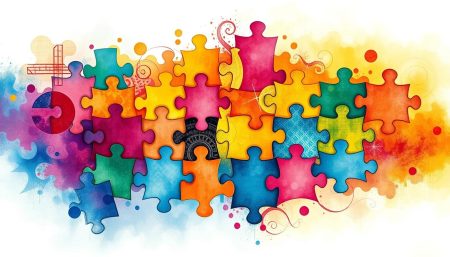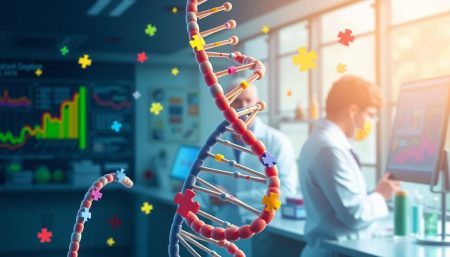Autism Spectrum Disorder is a complex condition that shows itself in many ways. It can make social interaction, communication, and behavior challenging. This guide aims to help you understand the signs and symptoms of autism. It’s a key autism symptoms checklist for those who deal with it every day.
Spotting these signs early is very important. It helps get the right help and support early on. This can really help improve the life of someone with ASD.
Knowing the signs of ASD helps us understand and support people who see the world differently. This guide is for parents, caregivers, teachers, and doctors in the U.S. It’s all about spotting signs early and making sure every child gets the chance they deserve.
We want to make a society that values and celebrates the unique qualities of those with ASD. With this guide, we’re committed to helping create a more inclusive world.
Understanding Autism Spectrum Disorder
Autism Spectrum Disorder (ASD) is a complex condition. It affects how people interact, communicate, and behave. In the U.S., it’s a big concern in child health, focusing on spotting autism early in toddlers and recognizing it in children.
Defining Autism Spectrum Disorder
The Centers for Disease Control and Prevention (CDC) says ASD is a developmental disorder. It impacts how people communicate and behave. It’s marked by trouble with social interaction and repetitive behaviors. This helps us understand the wide range of symptoms in each person.
Prevalence and Diagnosis
The CDC’s Autism and Developmental Disabilities Monitoring (ADDM) Network found about 1 in 44 kids have ASD. Early detection and treatment are key to better outcomes. Diagnosis involves many steps, including developmental screenings and genetic tests.
| Age | Screening Tests | Further Evaluation if Screened Positive |
|---|---|---|
| 18 months | M-CHAT-F | Comprehensive Developmental Evaluation |
| 24 months | M-CHAT-F | Neurological Assessment, Genetic Testing |
| 30 months | Pediatric Evaluation | Caregiver Interviews, Additional Behavioral Assessments |
Knowing the early signs of autism in toddlers and common signs in children helps. It lets professionals and parents act early. This can help build a strong foundation for dealing with the disorder.
Early Warning Signs of Autism in Toddlers
Spotting the early signs of autism in toddlers is key for early help. The American Academy of Pediatrics says to watch for certain signs. These early signs of autism in toddlers include not talking much, not gesturing like pointing or waving by 12 months, and not wanting to play with others.
Watching a toddler closely can show more subtle signs of autism. If they have trouble talking back and forth, don’t make eye contact, or don’t want to play with other kids, it might mean they need a specialist’s check-up. Knowing these signs early can help a lot through early intervention and support.
| Age | Expected Milestones | Signs of Possible Concern |
|---|---|---|
| 12 Months | Babbling, pointing, other gestures | Little to no babbling, pointing, or gesturing |
| 18 Months | Imitating others, recognizing familiar people | Poor imitation, indifference towards others |
| 24 Months | Two-word meaningful phrases (excluding imitating or repeating) | Lack of combined words, absence of spontaneous phrases |
Parents and caregivers should keep an eye on these behaviors and talk to doctors if they worry. Quick action on these signs can greatly help a child’s growth.
Recognizing Autism Early Signs for Timely Intervention
Finding the autism early signs in kids is key to getting them the help they need. This help can greatly improve their development and life quality. Knowing these signs helps parents and caregivers get a diagnosis sooner. This means kids can start early intervention programs sooner too.
The Early Intervention Program for Infants and Toddlers with Disabilities helps a lot. It’s part of the Individuals with Disabilities Education Act (IDEA). This program makes sure kids get the support they need when they’re growing up. By focusing on autism spectrum disorder signs and symptoms, we can use these programs better.
| Sign | Typical Age of Onset | Importance of Early Recognition |
|---|---|---|
| Lack of Response to Name | By 12 months | Early detection can lead to interventions that focus on improving communication skills. |
| Minimal Eye Contact | As early as 6 months | May suggest delays in social development, which are critical in the foundation stages. |
| Limited Gestures | By 10 months | Gestures are key in non-verbal communication; absence can indicate possible social communication issues. |
Spotting these autism early signs helps with early help. It also helps families and teachers make learning and social spaces better. Early help and diagnosis can boost kids’ thinking, talking, and social skills. This leads to the best results in managing autism spectrum disorder signs and symptoms.
Autism Spectrum Disorder Signs and Symptoms
Autism Spectrum Disorder (ASD) shows itself in many ways. These include how people communicate, their behavior, and how they process sensory information. Knowing these signs helps us understand what people with autism go through. It also helps us spot high functioning autism symptoms and signs of mild autism early on.
Social Communication Challenges
People with autism often struggle with social communication. This is a key area where they might need help. They might find it hard to keep up in conversations, understand body language, or make friends.
For those with ASD, social situations can be very challenging. It’s like trying to speak a language they’re not fluent in. This can make social events feel overwhelming.
Repetitive Behaviors and Restricted Interests
Repetitive behaviors and restricted interests are common in mild autism. This can mean repeating certain words or phrases, focusing intensely on specific topics, or sticking to routines very closely. These behaviors help some people with autism feel more in control in a world that can seem chaotic.
Sensory Processing Differences
Sensory processing differences are a big part of ASD. Some people with autism might be very sensitive to sounds, lights, textures, and tastes. Others might not react as much to these things.
These differences can really impact daily life. Places that are usually busy or crowded can be very overwhelming for them.
It’s important to understand these aspects of ASD. This knowledge helps not just those with autism but also their families, teachers, and friends. By recognizing these signs, we can make environments more welcoming and supportive. This helps everyone grow and understand each other better.
Behavioral Indicators of Autism in Children
Spotting signs of autism in children needs careful watching of their actions. These actions can vary a lot from one child to another. Some behaviors are more often linked to autism spectrum disorder.
Difficulty in Making Eye Contact
One key autism early sign is trouble with eye contact. Kids with autism often feel uneasy or too stressed by eye contact. This is very different from kids without autism.
Unusual Response to Affection
Another important sign is how they react to affection. Kids with autism might not act like others when shown love. They could seem not to care or even get upset by hugs or closeness. This can puzzle parents who don’t know about autism.

High Functioning Autism Symptoms
It’s important to know about high functioning autism symptoms to understand how it affects adults. People with autism often have smart thinking skills but face problems with social and communication. They might do well in school or work but find it hard to connect with others.
Adults with autism may find it tough to keep up in conversations or understand social hints. They might also have trouble making and keeping close friends. Yet, many with high functioning autism work regular jobs and live on their own. They find ways to cope and often go unnoticed by those who don’t know about their condition.
| Symptom | Description | Impact on Daily Life |
|---|---|---|
| Advanced Cognitive Skills | Above-average abilities in areas like memory, reading, or data analysis | Often leads to academic and professional success but might mask social deficits |
| Social Communication Issues | Difficulty with back-and-forth conversation, reading non-verbal cues | Challenges in forming and sustaining relationships |
| Nuanced Repetitive Behaviors | Engagement in repetitive behaviors, but not always obvious (e.g., patterned thinking) | Could lead to stress in unexpected changes or preference for high structure |
The National Institute of Mental Health says that with the right help, adults with autism spectrum symptoms can do better in social situations. This can help them live on their own and keep a job. Knowing about these symptoms helps us offer the support they need to live a better life.
Physical and Motor Signs in Autism Spectrum Disorder
Looking for early signs of autism in toddlers means watching their physical and motor actions closely. These signs are key to a full autism symptoms checklist, even if they’re not talked about as much as social or communication signs.
Unusual Posture or Gait
Children with autism often have unique physical traits. For example, walking on toes or having an odd gait can show sensory processing issues common in ASD.
Delayed Motor Skills Development
Seeing delays in motor skills is another important sign. This includes sitting, crawling, and walking late. These are key signs in any autism symptoms checklist. They often point to deeper issues in brain development linked to ASD.
| Motor Milestone | Typical Age Range | Observed Age Range in ASD |
|---|---|---|
| Sitting Without Support | 6 months | 6-9 months |
| Crawling | 9 months | 10-12 months |
| Walking | 12 months | 13-18 months |
Autism Symptoms Checklist for Parents
Creating an autism symptoms checklist is a key step for parents. It helps spot autism spectrum disorder signs and symptoms. This tool makes it easier to see behaviors that might mean your child needs a doctor’s talk.
This checklist is based on advice from the American Academy of Pediatrics. It lists important signs that could mean your child should be checked for autism.
| Age | Signs and Symptoms |
|---|---|
| 6 Months | Lack of big smiles or other joyful and engaging expressions |
| 9 Months | No sharing of sounds, smiles, or other facial expressions |
| 12 Months | Lack of response to name, no babbling or baby talk |
| 16 Months | Minimal or no words |
| 24 Months | Very few or no meaningful, two-word phrases (not including imitating or repeating) |
| Any Age | Loss of any previously acquired speech, babbling, or social skills |
An autism symptoms checklist is more than just a tool. It’s a way for parents to keep track of their child’s behaviors. This is important for talking to doctors or autism experts. Early help is key for managing autism spectrum disorder signs and symptoms.
Screening and Diagnosis of Autism Spectrum Symptoms
Understanding how to screen and diagnose autism is key for early help and management. Both autism spectrum symptoms in adults and signs of autism in children need detailed checks for correct diagnosis and care plans.
Standardized Developmental Screenings
The first step is usually standardized developmental screenings. These tools quickly check if kids are meeting basic skill milestones or if they might be delayed. The Modified Checklist for Autism in Toddlers (M-CHAT) is a top pick for spotting early signs of autism in children.
The Role of Pediatricians and Specialists
Pediatricians are vital in spotting autism early. They often notice unusual growth patterns that might point to autism spectrum symptoms in adults or children. After initial checks, experts like neurologists and child psychologists do deeper evaluations. They help figure out if it’s autism or something else and suggest the best treatments.
Understanding Signs of Mild Autism
Finding signs of mild autism can be tricky because they are not as obvious as other symptoms. This part talks about the small changes in social and adaptive skills that show high functioning autism.
Subtle Social Differences
People with mild autism might have trouble understanding gestures or facial expressions. These small issues can affect how they interact with others and handle social situations.
Adaptive Skills Variation
Adaptive skills are the everyday abilities needed to live and meet life’s demands. These include self-care, social skills, and physical abilities. Seeing how these skills vary is key to spotting high functioning autism symptoms. Some people with autism might excel in some areas but find simple tasks hard.

| Skill Type | Expected Level | Observed Level in Mild Autism |
|---|---|---|
| Communication Skills | Advanced | Basic to Moderate |
| Social Interaction | Spontaneous | Rehearsed or Restricted |
| Self-Care | Independent | Needs Assistance or Supervision |
It’s important to spot the signs of mild autism to help them live better lives. Knowing these small signs helps start early help and create better treatment plans.
Signs of Autism in Children vs. Adults
Understanding signs of mild autism and autism spectrum symptoms in adults shows big differences. Kids with autism often have trouble with language and social skills. Adults might find it hard to fit in at work or keep relationships, mainly because of social communication issues.
Autism in adults can be harder to spot because they’ve learned to hide their symptoms. They’ve developed ways to deal with the world, making their autism less obvious.
- Language and communication issues in children may manifest as delayed speech development.
- Adults might exhibit sophisticated vocabularies but struggle with the nuances of conversation such as timing and tone.
The Autism Spectrum Quotient (AQ) is a key tool for spotting these differences. It looks at social skills, attention, and imagination. It helps reveal signs that adults might hide.
Here’s a table that shows how autism symptoms differ between kids and adults in common areas:
| Domain | Children | Adults |
|---|---|---|
| Social Interaction | Difficulty in sharing interests; unresponsive to social cues. | Prefers solitary activities; challenges in maintaining relationships. |
| Communication | Limited use of gestures; possible delays in speech development. | Conversational challenges despite good vocabulary; misinterpretation of figurative language. |
| Behavior Patterns | Repetitive movements; insistence on sameness and routines. | Highly focused interests; rigid routines perceived as personal habits. |
Autism Spectrum Symptoms in Adults
Spotting autism spectrum symptoms in adults is tricky. These signs are different from signs of autism in children. Adults might struggle with social interactions, have deep interests, and stick to routines. These traits are often missed because of how society expects them to act and the coping strategies they’ve learned.
Many adults with autism don’t get diagnosed until later. This can cause big problems in their personal and work lives. Getting a diagnosis and the right support can really improve their life and how they connect with others.
- Routine reliance heavily impacting daily activities
- Specialized or niche interests that dominate time and conversations
- Social communication hurdles that complicate personal relationships and professional advancement
It’s key to understand these symptoms to help adults with autism. With the right support, they can use their strengths and deal better with social situations.
Support and Resources for Individuals with Autism
Getting the right support and resources is key for those with early signs of autism or a diagnosis of high functioning autism. Specialized educational programs and therapy help a lot. They improve learning and life skills.
Educational Support and IEP
The U.S. Department of Education makes sure public schools have Individualized Education Programs (IEPs) for students with autism. These plans are made just for each student. They help create a learning space that fits their needs.
IEPs are very important for managing autism symptoms in school. They help students learn and grow in a supportive way.
Therapy and Behavioral Interventions
Therapies like Applied Behavior Analysis (ABA) and Occupational Therapy (OT) play a big role. ABA helps with social skills, communication, and learning new things. Occupational Therapy focuses on daily living skills, helping with sensory issues.
Both therapies are key for early help, which is very important for toddlers. They can make a big difference in a person’s life.
| Therapy Type | Focus Area | Benefits |
|---|---|---|
| Applied Behavior Analysis (ABA) | Social Skills and Communication | Improves interaction abilities, reduces behavioral issues |
| Occupational Therapy (OT) | Sensory and Motor Skills | Enhances sensory integration, promotes independence in daily activities |
Differences in Autism Symptoms Between Genders
It’s important to know how signs of autism in children and high functioning autism symptoms show up differently in boys and girls. Studies show that autism can look very different in boys and girls. This affects how often they get diagnosed and how they are treated.
A study in the Journal of Autism and Developmental Disorders found that girls might not show symptoms as clearly as boys. This is because girls with autism might hide their social struggles. This hiding can make it hard for doctors to diagnose them correctly.
There’s a big difference in how often boys and girls are diagnosed with autism. Boys are about four times more likely to be diagnosed than girls. This difference is not just about biology. It also has to do with how society sees boys and girls and their behaviors.
- Boys are often diagnosed earlier and more frequently.
- Girls may display more subtle signs of autism in children, complicating early detection.
- Symptoms like social communication issues manifest differently often influenced by societal expectations.
We need to understand these differences better. This will help us create better ways to diagnose and support children with autism. We want to make sure every child gets the help they need as early as possible.
Navigating the Journey After an Autism Diagnosis
Getting an autism spectrum disorder diagnosis is a big moment for individuals and their families. It starts a journey that is special for each person. Knowing about autism signs and symptoms is key to moving forward.
While early signs of autism give a first look, a diagnosis offers a clear path. It helps find personalized care and support. Learning about autism helps families make informed choices for their loved ones.
The Autism Society of America is a source of hope and guidance. They provide resources to help families after a diagnosis. They stress the value of community support and networking.
These groups help share experiences and strategies. They push for therapy plans that help each person grow. It’s important to make sure those with autism get ongoing support and tailored help.
Every step after an autism diagnosis is a step towards understanding and acceptance. From using national resources to joining local support groups, the journey is filled with strategies. It’s about recognizing early signs and meeting changing needs with patience, compassion, and support.
FAQ
Q: What are the signs and symptoms of autism spectrum disorder (ASD)?
A: Signs of ASD include trouble with social communication and repetitive behaviors. People with ASD might also have sensory sensitivities and challenges in relationships. Early signs include not babbling or gesturing by 12 months, avoiding eye contact, and delayed speech.
Q: How prevalent is ASD and how is it diagnosed?
A: About 1 in 44 children have ASD, according to the CDC. Diagnosis involves developmental screenings and a detailed evaluation. This may include genetic testing and interviews with caregivers.
Q: What are some early warning signs of autism in toddlers?
A: Early signs in toddlers include not babbling by 12 months and not using gestures. They might also show little interest in social interaction and avoid eye contact.
Q: Why is early recognition of autism important?
A: Recognizing autism early is key for timely intervention. This is vital for improving developmental outcomes. Early Intervention Programs can help support children with disabilities.
Q: What are common repetitive behaviors and restricted interests observed in ASD?
A: People with ASD might repeat certain words or phrases. They might also have intense interests and strict routines. Their interests can be unusual and intense.
Q: How does autism affect social communication?
A: Autism makes social communication very challenging. It can be hard to keep conversations going and understand body language. Building and keeping friendships is also a struggle.
Q: What are some behaviors in children that may indicate autism?
A: Children with autism might not make eye contact or respond to affection in an unusual way. They might also play differently than their peers.
Q: What are the symptoms of high functioning autism?
A: High functioning autism symptoms include being very smart but struggling in social situations. People with this condition might have repetitive habits and find complex social interactions hard.
Q: Can motor skills be affected by autism?
A: Yes, autism can affect motor skills. People with autism might walk on their toes or have an unusual gait. They might also be slow to develop skills like sitting, crawling, and walking.
Q: What should parents look for in a checklist for autism symptoms?
A: A checklist for autism symptoms might look for a lack of shared enjoyment or play. It might also look for regression in language skills and consistent patterns of behavior that are different from what’s expected.
Q: How are standardized developmental screenings used in diagnosing autism?
A: Screenings like the Modified Checklist for Autism in Toddlers (M-CHAT) help spot early signs of autism. They guide further assessment and diagnosis by healthcare professionals.
Q: What are the signs of mild autism?
A: Mild autism might show as subtle social differences. This includes nuances in understanding non-verbal communication and challenges in group settings. People with mild autism might also have variations in adaptive skills and coping strategies.
Q: Are there different symptoms of autism in children compared to adults?
A: Yes, children with autism often have more obvious language delays and social challenges. Adults might have more subtle symptoms, like difficulties in professional settings and relationships. They might also struggle with social nuances.
Q: What symptoms might be observed in adults with autism spectrum disorder?
A: Adults with autism might rely on routines and have specialized interests. They might also struggle with social communication. They may find social situations difficult and benefit from a formal assessment and support.
Q: What kind of support and resources are available for individuals with autism?
A: Support includes educational plans, therapy, and behavioral interventions. This includes ABA and OT. There are also community and national organizations like the Autism Society of America that offer advocacy and resources.
Q: How do autism symptoms differ between genders?
A: Autism symptoms might be less noticeable in females, possibly due to better social camouflage. Boys are about four times more likely to be diagnosed with autism than girls. This might suggest gender-related differences in symptom expression or recognition.
Q: What steps should be taken after receiving an autism diagnosis?
A: After a diagnosis, seek ongoing education and community support. Create individualized therapy plans to support development. National organizations provide valuable resources to help families on their journey.


















